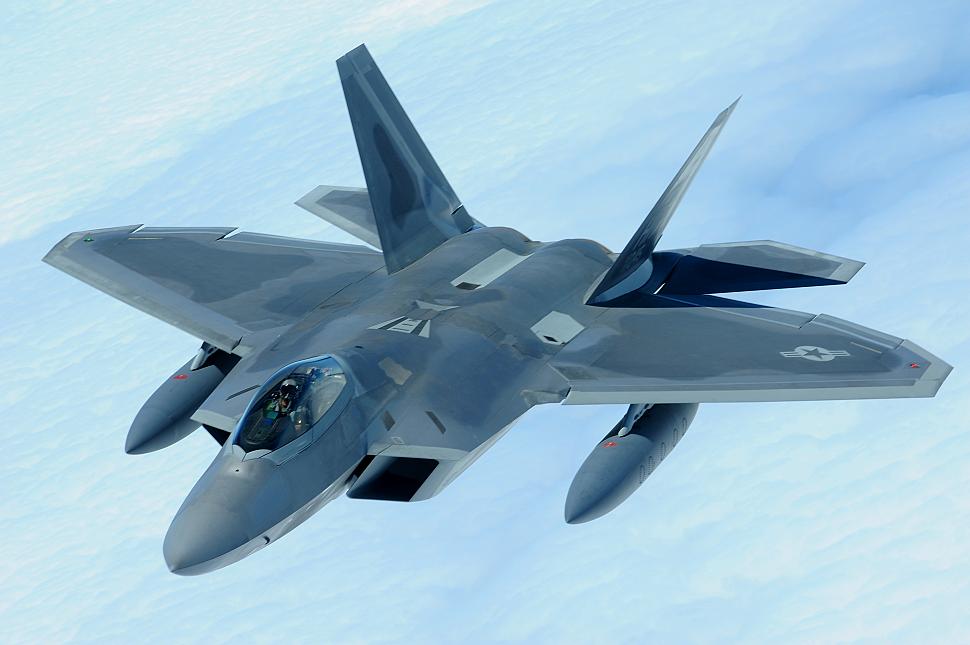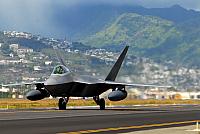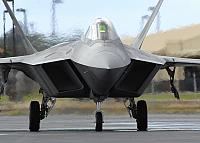Fighter Jet News
F-22 Raptor News
Hawaii ANG has full complement of F-22 Raptors
September 20, 2012 (by
William Cole) -
Five Hawaii Air National Guard F-22 Raptors roared off Honolulu Airport's reef runway one after another Wednesday, the thrust vibrating the air as the final jet rocketed nearly vertically 24,000 feet into a blue Hawaii sky.

The 199th Fighter Squadron reached its full complement of 18 jets about a week ago, more than two years after the first of the stealth fighters arrived in July 2010. Two other jets are on the mainland for maintenance.
The milestone is another along the way in establishing the Hawaii Air Guard as a go-to force in the Pacific, flying the Air Force's premier fighter jet.
Two squadrons of what the Air Force calls a "fifth-generation fighter" — the latest and greatest — are based in Alaska, meaning that three squadrons of the aircraft, including Hawaii's, are devoted to Asia and the Pacific.
"There are very few fifth-generation fighters in the Air Force, and being a part of those, whether it's at Joint Base Pearl Harbor-Hickam or up in Alaska, it just makes you a little more high-visibility," said Lt. Col. Mark Ladtkow, the commander of the Air Guard's 199th Fighter Squadron.
That visibility has included deployments of Raptors from the East Coast to Japan in July and F-22s from Alaska on a current rotation to Guam in support of U.S. Pacific Command's "security obligations in the western Pacific," the Air Force said.
The F-22's combination of stealth, maneuverability, avionics, and the ability to cruise at supersonic speeds without afterburners "cannot be matched by any known or projected fighter aircraft," the Air Force said.
Both the Hawaii Air Guard and active duty Air Force fly and maintain the Hawaii-based Raptors in about a 75-25 split, with the Guard "owning" the aircraft and having the larger share of flying and maintenance duties, officials said.
Officials said full operational capability is expected sometime during fiscal 2013, which starts Oct. 1.
Ladtkow said while the airplanes are mission-capable, he's still waiting on some pilots to come out of training to reach a full complement of 27 Guard and nine active-duty pilots.
The training flights Wednesday north of Oahu included the five Raptors, four F-16 Fighting Falcons with the Texas Air National Guard and two F-15 Eagles from the Montana Air National Guard, which for nearly two years has been fulfilling an air defense role for Hawaii as the F-22 numbers have slowly built up.
The F-16s are in Hawaii for regularly scheduled training called Sentry Aloha.
Maj. Kristof Sills, an Air Guard F-22 pilot who grew up in Hawaii, said he was part of a Raptor escort Wednesday for F-15 Eagles simulating a bomb drop on hostile territory, with F-16s playing the "red," or enemy air force.
"The F-16s did a great job replicating red air, so they simulated a threat nation using their threat tactics and we were able to get the job done and we got some great (training)," Sills said.
The Raptor is an "awesome" aircraft, he said.
"I flew the Eagle for 10 years and the F-15 Eagle is an outstanding airplane, but the F-22 Raptor is just so much better," he said.
Oahu residents won't be seeing the Raptors more often, with the aircraft already flying Monday through Friday and on some weekends, but they will see them in greater numbers — anywhere from six to nine up to twice a day, Ladtkow said.
A series of hypoxia problems — pilots not getting enough oxygen — plagued the costly jets nationwide and delayed the arrival of the final four jets to Hawaii.
A Hawaii Air Guard F-22 Raptor pilot declared an "in-flight emergency" July 6 after experiencing momentary dizziness, but landed safely at Hickam. It was the first reported case of hypoxia-like symptoms experienced by a Hawaii-based pilot, the Hawaii National Guard said.
The Air Force said it is continuing to address the problem with fixes to oxygen systems and changes to the upper part of a pressure suit.
The Raptors flown by the Hawaii Air Guard are expected to take back the Hawaii air defense mission from the Montana Air Guard in December, an official said.
The aircraft will be deployed more, too, meaning more time away from Hawaii for some of the planes and crew.
"We'll be gone a lot longer than what we were accustomed to deploying as a Guard unit," said Tech Sgt. Robert Rabacal, 33, a crew chief who grew up in Ewa Beach. "I'm looking forward to it."

USAF F-22A block 20 no. 03-4045 flying over the Pacific Ocean on its way to its new home, Joint Base Pearl Harbor Hickam on July 2nd, 2010. The 199th FS of the HIANG is transitioning from the F-15 and will serve as the only ANG led joint Guard and Active Duty squadron in the Pacific and the second in the USAF. [USAF photo by SrA. Gustavo Gonzalez]
The milestone is another along the way in establishing the Hawaii Air Guard as a go-to force in the Pacific, flying the Air Force's premier fighter jet.
Two squadrons of what the Air Force calls a "fifth-generation fighter" — the latest and greatest — are based in Alaska, meaning that three squadrons of the aircraft, including Hawaii's, are devoted to Asia and the Pacific.
"There are very few fifth-generation fighters in the Air Force, and being a part of those, whether it's at Joint Base Pearl Harbor-Hickam or up in Alaska, it just makes you a little more high-visibility," said Lt. Col. Mark Ladtkow, the commander of the Air Guard's 199th Fighter Squadron.
That visibility has included deployments of Raptors from the East Coast to Japan in July and F-22s from Alaska on a current rotation to Guam in support of U.S. Pacific Command's "security obligations in the western Pacific," the Air Force said.
The F-22's combination of stealth, maneuverability, avionics, and the ability to cruise at supersonic speeds without afterburners "cannot be matched by any known or projected fighter aircraft," the Air Force said.
Both the Hawaii Air Guard and active duty Air Force fly and maintain the Hawaii-based Raptors in about a 75-25 split, with the Guard "owning" the aircraft and having the larger share of flying and maintenance duties, officials said.
Officials said full operational capability is expected sometime during fiscal 2013, which starts Oct. 1.
Ladtkow said while the airplanes are mission-capable, he's still waiting on some pilots to come out of training to reach a full complement of 27 Guard and nine active-duty pilots.
The training flights Wednesday north of Oahu included the five Raptors, four F-16 Fighting Falcons with the Texas Air National Guard and two F-15 Eagles from the Montana Air National Guard, which for nearly two years has been fulfilling an air defense role for Hawaii as the F-22 numbers have slowly built up.
The F-16s are in Hawaii for regularly scheduled training called Sentry Aloha.
Maj. Kristof Sills, an Air Guard F-22 pilot who grew up in Hawaii, said he was part of a Raptor escort Wednesday for F-15 Eagles simulating a bomb drop on hostile territory, with F-16s playing the "red," or enemy air force.
"The F-16s did a great job replicating red air, so they simulated a threat nation using their threat tactics and we were able to get the job done and we got some great (training)," Sills said.
The Raptor is an "awesome" aircraft, he said.
"I flew the Eagle for 10 years and the F-15 Eagle is an outstanding airplane, but the F-22 Raptor is just so much better," he said.
Oahu residents won't be seeing the Raptors more often, with the aircraft already flying Monday through Friday and on some weekends, but they will see them in greater numbers — anywhere from six to nine up to twice a day, Ladtkow said.
A series of hypoxia problems — pilots not getting enough oxygen — plagued the costly jets nationwide and delayed the arrival of the final four jets to Hawaii.
A Hawaii Air Guard F-22 Raptor pilot declared an "in-flight emergency" July 6 after experiencing momentary dizziness, but landed safely at Hickam. It was the first reported case of hypoxia-like symptoms experienced by a Hawaii-based pilot, the Hawaii National Guard said.
The Air Force said it is continuing to address the problem with fixes to oxygen systems and changes to the upper part of a pressure suit.
The Raptors flown by the Hawaii Air Guard are expected to take back the Hawaii air defense mission from the Montana Air Guard in December, an official said.
The aircraft will be deployed more, too, meaning more time away from Hawaii for some of the planes and crew.
"We'll be gone a lot longer than what we were accustomed to deploying as a Guard unit," said Tech Sgt. Robert Rabacal, 33, a crew chief who grew up in Ewa Beach. "I'm looking forward to it."
Courtesy of The Honolulu Star-Advertiser as published on September 20th, 2012 in the Stars and Stripes.
Used with permission from Stars and Stripes, a DoD publication.
© 2012 Stars and Stripes.
Related articles:
Forum discussion:
Tags
- F-22 Raptor rolls out in Hawaii ( 2010-07-12)
- HIANG newest guard wing to fly F-22 Raptor ( 2010-07-09)
- Hawaii ANG to receive first F-22s in 2010 ( 2008-07-23)
- F-22 Raptor news archive
Forum discussion:
- Start a discussion about this article in the F-22 forum.
Tags
Additional images:

USAF F-22A block 20 no. 03-4045 taxing on the flight line at Joint Base Pearl Harbor Hickam, Hawaii on July 2nd, 2010. The 199th FS of the HIANG is transitioning from the F-15 and will serve as the only ANG led joint Guard and Active Duty squadron in the Pacific and the second in the USAF. [USAF photo by SSgt. Mike Meares]

USAF F-22A block 20 no. 03-4046 on the flight line at Joint Base Pearl Harbor-Hickam, Hawaii on July 9th, 2010. The 199th FS of the HIANG is transitioning from the F-15 and will serve as the only ANG led joint Guard and Active Duty squadron in the Pacific and the second in the USAF. [USAF photo by TSgt. Jerome S. Tayborn]
